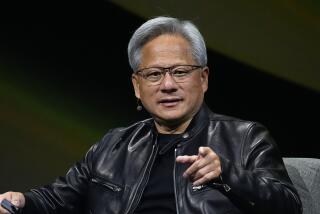U.S. Playing Catch-Up in the Robotics Race : Automation: Though the technology was pioneered here, America must make great strides before its industry thrives like those in Japan and Europe.
- Share via
AUBURN HILLS, Mich. — American industry is placing record orders for robots to wield its arc welders and swing its paint sprayers, but the future of U.S. robot manufacturing is far from automatic.
America invented the industrial robot, but its largest seller now, GMFanuc Robotics Corp., imports most of its machinery from Japan.
And the largest U.S. manufacturer, Cincinnati Milacron Inc. of Ohio, said in February it would sell out to Swiss-based Asea Brown Boveri AB.
The changes illustrate the head start Japan and Europe have in robot use and the catching up the United States must do before its own robot industry can thrive.
“There’s tremendous potential, yet it’s lower than our Japanese counterparts,” said Eric Mittelstadt, president of GMFanuc. “They sell almost as many in a year as we have installed in the history of robotics.”
Robotics got its start in the United States, said Joseph Engleberger, who founded the world’s first industrial robot manufacturer, Unimation of Danbury, Conn., 30 years ago.
“We originated all the technology,” said Engleberger, whose pioneer robot ran for 100,000 hours in a General Motors Corp. factory before it was enshrined in the Smithsonian Institution in Washington.
But the idea of robots caught on faster in countries like Japan and Germany because labor there was harder to find, and more expensive, said Patrick McGibbon, robots analyst with the U.S. Commerce Department’s International Trade Administration.
Now Japan has 176,000 industrial robots to the United States’ 37,000. In robots per production worker, the United States trails Japan, Sweden, Germany and Italy, according to the Robotic Industries Assn.
“Our key competitors, Japan and Germany, are increasing their usage at a faster rate than we are, not a good sign for the competitiveness of American industry,” spokesman Jeffrey Burnstein said.
Yet orders for American robots are growing, the Ann Arbor-based trade group said. Manufacturers placed a record $517.4 million in robot orders with U.S. companies last year, up 33% from $388 million in 1985.
Robots usually conjure up images of science fiction characters like R2D2 in “Star Wars,” or devoted servants without such human drawbacks as boredom, independent thinking, inattentiveness or the need for health and retirement benefits.
Robot makers usually focus on more vital roles, such as helping hospital patients, exploring the ocean floor, handling hazardous waste or defusing bombs.
“I pushed the use of personal robots in health care,” said Walter Weisel, president of Prab Robots Inc. in Kalamazoo until 1989, when he resigned and became an industry consultant.
“That market is so big that whenever it gets rolling it’s going to dwarf whatever happens in industrial robots,” Weisel said.
On the GMFanuc plant floor, yellow and black robot arms whirl, bob and turn like long-necked birds as the $30,000 to $100,000 systems go through the programmed motions they’ll carry out in customers’ factories.
Robot welders trace the patterns of seams they’ll join. Spray gun robots move over and under car bodies and other shapes they’ll paint.
Robots with suction-cup arms pluck panes of glass from stacks, tilt them back and position them in the window openings of car and truck frames.
Plant workers are inured to the idea that automation has its place. “We’ve been dealing with robots for 20 years now,” said United Auto Workers spokesman Reg McGee.
In fact, when robots are brought in, the union often is involved from the start, with its own skilled tradespeople installing them, McGee said. He said the robots have also prompted job bank programs to retrain displaced workers.
GMFanuc, a joint venture of General Motors Corp. and Fanuc Ltd., Japan’s largest robotics company, occupies a glass-walled building on 56 wooded acres 20 miles north of Detroit. Gravel and dirt still occupy part of the building that remains to be finished as sales rebound from a low of $103 million in 1987.
The dip came after GMFanuc lost $90 million in orders from auto makers, who pleaded slow sales and a shortage of cash, said company president Mittelstadt. Since then, GMFanuc has increased its percentage of non-automotive business from 10% and 15% to 40%.
It’s also cut its dependence on GM, selling robots to Ford, Chrysler, Nissan, Toyota, Peugeot, Saab and Volkswagen.
The company uses every marketing tactic available, from working with state development agencies to making telephone pitches to machine shops and small manufacturers.
Sales last year totaled a record $223 million, Mittelstadt said.
The U.S. Commerce Department’s 1991 U.S. Industrial Outlook described the robotics market as promising but said 1990 shipments grew too slowly.






